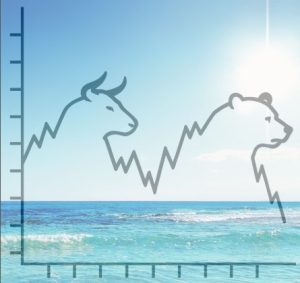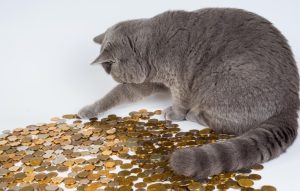What’s a Darvas Box?
I have had a few queries about Darvas boxes and since I didn’t mention them in my books, I probably should explain what they are and how they are used. Firstly, let’s look at Nicholas Darvas and how he ‘invented’ them. It’s a fascinating story.
Who was Nicholas Darvas?
Nicolas Darvas was a professional dancer, self-taught investor, and author. He is best known for his book, “How I Made $2,000,000 in the Stock Market.”

It’s a good read if you haven’t already read it. It became a bestseller. He authored several other books, including Wall Street: The Other Las Vegas and The Anatomy of Success
Originally he was an economist who fled Hungary in 1943 when it looked like the Nazis might take over. and with his half-sister came to the U.S. and they became a well-known dancing team.
Darvas starts to invest
Darvas’s interest in the stock market began in 1952 when he accepted shares of a Canadian mining company, Brilund, as payment for a performance. These shares appreciated significantly, sparking his curiosity about investing. He immersed himself in market studies, reading over 200 books on the subject and analyzing stock price movements during his free time.

Darvas Box Theory
Darvas developed the “Darvas Box Theory,” a trading method that identifies a stock’s price range (box) and signals a buy when the price breaks above this range. (it is often added in that it is on increased volume, however, as you will see volume was not part of the theory).
He would buy when stocks broke out of this box on the upside, and sell when they dropped through it on the downside.
The Darvas Telegrams
What I found fascinating was how he did it. Being a professional dancer, he was often out of the country, performing overseas. In the 1950s there was no internet or cell phones. He relied on his broker to send him daily telegrams of the daily high and low of the stocks he was interested in. He used these to construct a ‘box’ in which the stock was trading. The telegrams looked like this:
IBM 34 – 37 AAPL 88 – 92 GM 55 – 58
From this Darvas would construct a ‘box’ in which the stock was trading, to help him visualize. When it broke out of the box (on the upside) then he would buy. He did this by sending a telegram to his broker, which would look like this.
BUY 1000 IBM @ MKT STOP 34.
Obviously, he had to buy at market as his data was at least a day old, and the stop would be the lower bound of the box.
Emotional Detachment
How much more emotionally detached can you get? He couldn’t see news headlines, analyst opinions, or intraday moves—only daily highs and lows for the stocks he was following.
He couldn’t see the waves – all he could see was the tide!
Darvas returns to New York
After making disciplined, rule-based trades via telegram while touring internationally, he had built up his capital to $100,000. Darvas returned to New York, and traded from his broker’s office.
He was in the customer’s room, where clients could sit, watch the ticker, and follow the market in real time. Not only did he have full access to real-time stock prices and news, he also was subject to other brokers’ opinions. Initially, he was excited, thinking this access would improve his results. But instead . .
Darvas falls apart
Instead of improving, his trading fell apart: he abandoned his system, began overtrading (jumping in and out of positions), and listening to news and tips. And guess what: he lost money. In his own words:
“But instead of this helping me, it proved my downfall. I watched the tape for hours. I listened to all the rumors. I talked to other clients. I acted on tips. I second-guessed myself. In short, I did everything I had trained myself not to do.”
Diary of a madman
I read his books many years ago, and this passage really stuck in my brain:
“I looked at my broker’s statement. It looked like the diary of a madman. I had bought and sold over and over again, jumping in and out of stocks. What had happened to me?”
Why did this resonate with me? Probably because I recognised this in myself. Instead of slowing down and thinking things through logically, I followed every lead, continually searching for new information that was going to make all the difference (yeah, right!) and assuming that everyone except me knew these ‘market secrets’, I just had to dig deep and find them. Not smart.
Too much information
He goes on to reflect:
“When I was abroad, I had only the stock tables and my charts. I had only my brain to guide me. I had to be logical. Now, surrounded by every kind of information and advice, I was reacting emotionally, like a puppet.”
And:
“It seemed the more information I had, the more confused I became. I began to realize that the secret of my success abroad had been not my method alone, but the fact that I was physically removed from Wall Street.”
The Big Realization
Darvas realised that being far from the market, and receiving only price data, had been a benefit, not a limitation. The lack of noise had forced him to be objective, stick to rules, and ignore short-term emotions.
Too much information and access can destroy discipline.
Darvas leaves New York
“I decided to get away. I returned to Paris, not for relaxation, but to think over what had happened to me and to try to find out why I had lost control of myself.”
While in Paris, he began trading again remotely via telegrams—the very setup that had originally worked for him. This was a turning point.
Once back in Europe and cut off from the distractions of Wall Street, his performance dramatically improved, and he began the trading run that eventually turned $10,000 into over $2 million. (yes, I know that this was questioned later, but that is another story) during the bull market of 1957 – 1957. While the market gained 40%, Darvas gained 1,900%.
How to draw a darvas box
- Wait for a new high: A stock makes a new recent high (e.g. a 52-week high or similar significant move).
- Watch for sideways movement: The stock stops rising and begins to move sideways for at least 3 consecutive days.
- During this time, the high is not exceeded, and the lows are roughly stable.
- Define the box: Top of the box = the recent high (unbroken over at least 3 days). – Bottom of the box = the lowest low in the consolidation period.
- Buy only on breakout: If the price breaks above the top of the box, he would buy. He did not buy inside the box or anticipate the breakout.
- Set a stop-loss: His initial stop-loss was just below the bottom of the box.
Darvas did NOT use:

- No volume data
- No fundamentals
- No news or earnings reports
- No analyst opinions
He relied purely on price action, with discipline and emotionless execution
Darvas Box: SPY Example
Here’s an example we used when SPY was climbing out of the bear market. Note that the boxes do not conform to the rules exactly – but they were still helpful in seeing what was going on.

To the markets . .
An uneventful week (chart wise) – everything moving up nicely. The S&P 500 and the Nasdaq both made fresh highs. Nice. Let’s check the charts.
SPY Charts
SPY continues in its uptrend, and shows no sign of a drop off in volume. There’s now around $40 difference between the 10 and 200 SMAs.

On the weekly chart it is closing in on its previous uptrend (red).

SPYG Charts
SPYG is also going up nicely.

On the long term chart SPYG is now over the red uptrend – which often means that there is going to be a retracement. Will it happen? Maybe. Maybe not.

QQQ Charts
QQQ is still moving up steadily.

The long term chart shows QQQ in the middle of its trading channel.

VIX Chart
The Vix is definitely in low volatility territory.

ITMeter

The week ahead . .
The Fed meets on July 29–30, and the decision will be announced on Wednesday, July 30, at 2:00 p.m. Eastern Time. The expectation is that the Fed will maintain the rate at 4.25%–4.50% but there’s dissent in the ranks: Fed Governors Christopher Waller and Michelle Bowman have advocated for an immediate rate cut, citing concerns over economic softness and labor market trends. Interesting, no?
There’s some economic data:
- Wednesday: Q2 GDP Estimate
- Thursday: Core Personal Consumption Expenditures (PCE) (expected to rise 0.27% month-over-month and 2.7% year-over-year)
- Friday: July Employment Report
Earnings reports: Meta Platforms and Microsoft: on Wednesday, July 30, Amazon and Apple on Thursday, July 31.
And, of course, the tariff saga continues. President Trump has set an August 1 deadline on the EU, Canada, and Mexico, pending trade negotiations and the U.S. and China have agreed to extend their trade truce by another 90 days, with ongoing negotiations.
The futures
I can’t do this week as they are not open yet and tomorrow I will be flying all day. Sorry!
This week’s blog comes to you from . .
Switzerland. Stunningly beautiful. Every time I come here I am surprised again at how amazing it is. But wildly expensive.
I strayed into Italy one day by mistake.(long tunnel, no going back!)
I had lunch in Aosta, and was knocked out at the prices – one quarter of those in Switzerland.


Walking around Verbier (where I was staying) I came across the bear statue – terribly fierce, and I wondered if it was a bad omen. I walked a little further and saw the bull, a much better omen. To be abrolutely truthful it was a cow, but I made sure only the front part was in the photo!


Fingers crossed for a good week!
Heather
Trade the tide, not the waves



























15 Responses
Hello Heather ,
Just curious:
In times like this when we originally purchased our contracts when the VIX was high and is now much lower, do you ever do a volatility rebalance? ( sell our current contracts and buy new ones ?) ( I feel that our leverage is decreasing beyond that of our percentage position ) I hope this makes sense 🙂
Thank you
Joe
Hi Joe – I don’t do a volatility rebalance, but I certainly do leverage rebalances.
For example, if you bought a 50% strike (e.g. SPY at 500, strike 250) then if SPY moved up to $600 then you would only have a 41.7% strike, so I would sell the 250 and buy a 300 strike (to maintain the 50% leverage).
Hope this helps
h
Got it, thanks for the time Heather
How I made $2 million by Darvas is another one of my favorite trading books. It shows again that there is more than one way to make money in the Market. He found something that worked extremely well for him and he stuck with it. That is the secret to a trading life. Darvas boxes are great for trending markets up or down. Too bad not all charting software includes them.
Hi Tommy – I loved it too – although it doesn’t knock ‘Reminiscences of a stock operator’ off its perch!
Re more than one way to make money – yes, the market is a source of constant fascination for me, can’t resist looking for new / different ways.
I’m a bit of a nerd that way!
h
Welcome to the searching Nerd Club.
Haha – maybe we should start one – i will see if nerdclub.com is available!
Oh dear:
Sorry! nerdclub.com is taken.
Back to thr drawing board!
h
Greetings, Heather! In your charts (for example, the above SPY chart), what monetary unit does the vertical axis represent? Thanks!
HI Stephen, the vertical axis is in USD ($).
h
Just a super synopsis on the Darvas method. Beginning to think I should just send you the money for the price of the Darvas book. One more example of you showing how much you care for your readers. I hope this expression of appreciation represents that of many of your other readers even if they have not expressed it in writing here. Way too often, I am also guilty of not expressing that appreciation.
Thank you John! Your kind words are much appreciated!
Although I am not going to dissuade you from reading the Darvas book – it is really interesting.
x
h
The Darvas box reminds me of P & F charting that Charles Dow did in the 30’s … it leaves out volume tho. When did companies start ( or had to ) report earnings? It would seem to me as a thorn in one’s side in buying while away from information about stocks.
r
Hey Randy – the quarterly erporting started in 1970 – but since 1934 companies had to report ‘regularly’ but I’m not quite sure what ‘regularly’ means! Presumably less than quarterly.
So Darvas would not have had access to earnings reports – btu I don’t think (with, admittedly , no solid information) that in his time stocks were quite as volatile. ( !I should check that. before I say it)
But if they were only reporting ,say, once a year then the chances are that he wouldn’t be affected – a 0.4% chance maybe? (1 trading day out of 250 a year).
Its all speculation on my part!
h
Thank you for Darvas info.
Hey Michael – thank you for suggesting it! Its good to write about something people are curious about.
h